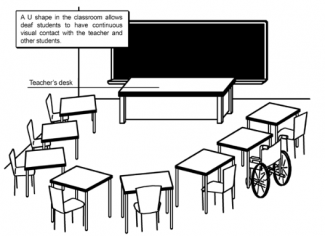Classroom
Adaptation, accommodation and support for girls and boys with disabilities can most often be provided in ordinary classrooms, also in emergency contexts.
Some rather simple ways to improve the accessibility and learning environment in the classroom:
- Consulting children and parents to discuss about arrangements that could be made in the classroom. Invite them to visit the school facility,
- Whitewashed walls can help all children to see better,
- Ensuring a safe and barrier-free environment: remove all objects from the floor that can hinder movement for wheelchair users or children with low vision or that are blind.
- Organise desks so sufficient space is available for all children to move freely,
- Arranging the classroom so that the desks are not aligned (in U or group desks for instance) can help children to work in small groups and can encourage cooperative learning,

©Adapted from Sarah Riazati, DeafCulture, 2017
- Set-up a buddy system where peers are supporting each other, which particularly can support the self-confidence and practical needs of children with disabilities,
- Maximising natural light and flow of air,
- Reducing as much as possible noise to make sure all children can be attentive to the teacher,
- Envisage adaptive furniture (height of the chairs and the desk) and propose the teacher to move around the classroom to be seen and attentive to all the children.
If schools have been damaged during the emergency, use the rehabilitation or reconstruction/repair of damaged school buildings, grounds and paths as an opportunity to improve accessibility for children with disabilities.